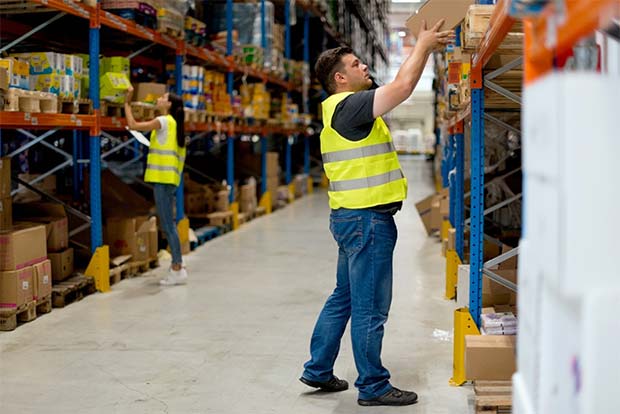The increasing demand for goods and services is affecting suppliers, manufacturers, and distribution centres (DCs) as well as the consumers. In the run-up to Black Friday and Christmas this will become much more apparent. Companies are struggling to replace the EU staff who used to fulfil the temporary jobs in the festive period. Not only is there a well-documented shortage of HGV drivers, but there is also a shortage of warehouse workers. The shift from physical stores to online means more labour is needed in DCs and warehouses than ever.
 The labour market for warehouse workers
The labour market for warehouse workers
The labour crisis is being felt particularly in areas such as central England where there is a heavy concentration of DCs. There are thousands of available vacancies, mostly for operatives dealing with picking and packing processes. The UK Warehousing Association (UKWA) reports that members have to increase the hourly pay between 20% and 30% to secure workers for entry-level jobs.
The extra hourly costs are shrinking margins and are likely to be passed on to the customer, ultimately affecting sales.
Improving manual processes in the warehouse
Within non-automated warehouses, workers move items at every stage from unloading incoming trucks to packing, picking and loading trucks for delivery. It is possible to improve productivity even in manual activities:
• Every item must have a dedicated location in the warehouse
• Allocate specific zones in the warehouse to store items that generate most traffic
• Use appropriate storage solutions e.g., fast-moving goods on pallets
• Combine similar orders to reduce workers travel time in picking
Picking and Packing Solutions
Improving efficiencies and reducing headcount are the main reasons to automate. Picking of items using the fewest resources at the lowest cost is critical.
Some automated solutions include:
• Semi-automated bagging where the bag is presented to the packer to fill. The label is automatically applied to it and the bag is dropped into a container for dispatch.
• Fully automated bagging is an in- line solution that shapes the bag around the item
• Automating the boxing of items is when a machine cuts a box to size and automatically closes it. This solution is for the protection of fragile and high-value items.
Automation of picking and packaging means quicker preparation, smoother transfer of parcels to the dispatch area. Fully automating your bagging and/or boxing is recommended when volumes demand it. Additional benefits are that equipment makes fewer mistakes and machines can be on duty 24/7.
Moving goods with less labour
The rapid movement of goods means lower management costs, improved revenues, and satisfied customers. With the rising cost of labour, automated solutions are looking much more attractive. Automated guided vehicles (AGVs) can replace forklifts and are practical in small distribution centres. Their cost is continuing to decrease. Drones that have embedded scanners increase the speed and accuracy of stock control by navigating warehouse shelves and taking automatic stock counts. Cloud-based software solutions are increasing productivity through online real-time access to user-friendly systems. Devices such as mobile phones, wearables, sensors and radio-frequency identification tags (RFID) reduce human error.
First steps towards automation
The specialist consultants at SCCG can help you to identify, access, and compare the benefits of the best tools available based your current situation and future business plans. We can identify the high-volume repetitive processes that take up too much time and consider automated solutions that can simplify tasks and eliminate manual processes and further help you in overcoming the staff shortage.
Regardless of the nature of your business, the specialist SCCG consultants can find the right balance between suitable and affordable technologies and the right level of human resources.




Comments are closed.